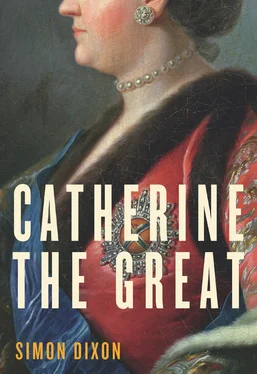For a further representation of the power and prosperity that Elizabeth claimed to have brought to the Russian throne, visitors to Tsarskoye Selo had only to glance up at the ceiling in the Great Hall. In the words of the artist, Giuseppe Valeriani, his painting’s allegorical central panel depicted:
Russia seated amidst the coats of arms of the Kingdoms and Provinces of her Empire, leaning on one where the Crowned Name of Her Imperial Majesty can be seen surrounded by Graces with festoons of flowers; next to her is Abundance, pouring out horns of fruit; on every side there are the Genies of War and Peace.
In the foreground are the Sciences and the Arts, Navigation and Commerce which the Genies of Her Majesty’s Magnanimity and Magnificence pour their Horns of Plenty to recompense and encourage the Sciences and the Arts.
In the niches at the four corners are the four parts of the World expressing their just admiration for the heroic virtues of Her Imperial Majesty. 55
The New Year firework in 1751 represented the northern hemisphere of a colossal globe, where the empress’s initials burned at the centre of a vast map of Russia. 56Writers conveyed similar messages, sometimes in overtly sexual terms. In Lomonosov’s anniversary ode for 1748, for example, Russia ‘sits and spreads her legs upon the steppe’, turning her ‘lively eyes’ to ‘take stock of the prosperity around her, leaning with her elbow on the Caucasus’. 57Masculine associations were even more frequent. Female rule had been associated with bravery in Russia since Catherine I’s legendary role at the battle of the Pruth in 1711, and Elizabeth’s clerical mythmakers duly seized on the image to portray their empress as ‘Peter’s daughter’. 58
Since no artistic form was better suited to represent heroism than opera, opera libretti, usually published simultaneously in St Petersburg in Russian, Italian and French, added to the chorus. As Jacob Stählin reminded readers of the St Petersburg News , everything in opera was ‘exaggerated, magnificent and amazing. It contains nothing save high and incomparable deeds, godlike faculties in man, a prosperous world, and portraits of golden ages.’ 59Giuseppe Bonecchi drove the point home by announcing that the hero of Araja’s opera Bellerofont , staged to commemorate the anniversary of Elizabeth’s accession in 1750, was intended to represent ‘an image of Her Imperial Majesty, who, gloriously surmounting on that day all the obstacles that injustice and envy had placed in her way, came to the paternal throne, to which she has consistently brought glory, and to which she gives by her virtues more éclat than she receives in return’. 60Indeed, the very presentation of Italian opera in St Petersburg was widely interpreted as evidence of the civilised blessings that Elizabeth’s rule had conferred on her empire. As Voltaire declared in his Anecdotes on Peter the Great , published in 1748 to flatter the Russian Court: ‘Magnificence and even taste have in every respect replaced barbarity.’ 61
In such a cultural climate, only the monarch mattered. Although Catherine’s birthday (21 April) and her name day (24 November) were cause for formal celebration, as were Peter’s (10 February and 29 June), these were secondary events, designed more to promote the dynasty than to fete the heir and his wife. Throughout Elizabeth’s reign, the most important days in the Court calendar were, in descending order of significance, the empress’s accession day (25 November), coronation day (25 April), name day (5 September) and birthday (18 December). It was these that provided the occasions not only for operas and literary commemorations, but also for extravagant banquets culminating in the presentation of intricate allegorical desserts, each of which was a work of art in itself.
By the middle of the eighteenth century, the sugar subtleties first created for medieval Arab potentates had slid far enough down the English social scale to be recommended by Hannah Glasse in The Art of Cookery (1747), one of the bestselling books of the age: ‘If you make them in pretty little figures, they make a fine little dish.’ 62In Russia, they remained a novelty confined to the Court elite, though a marginally wider group of readers could drool over the descriptions that appeared in the official press. To celebrate one of her triumphs against the Turks in the late 1730s, Anna’s Parisian confectioner made a model fortress complete with twelve sugar cannons; on another occasion, the dessert resembled the park and gardens at Peterhof. 63Under Elizabeth, designs became more ambitious still. At the first coronation-day banquet Catherine attended, shortly after her recovery from illness in April 1744, the dessert took the form of a coronation hall, complete with throne and regalia. ‘Among the subtleties at high table,’ reported the St Petersburg News , ‘there were various triumphal gates with avenues, and magnificent buildings with entertainment gardens and parterres ; incidentally, the chamber of the Imperial Academy of Sciences and the Kunstkamera with its observatory in St Petersburg were also represented, in models done to scale.’ 64
Sheer extravagance was itself a powerful enough symbol of prosperity, and Rastrelli’s favourite device, used on many occasions after Catherine’s wedding, was a pyramid of fire created by setting light to wax poured through thousands of glass globes. 65These were merely the centrepiece of fantastic theatrical settings. Fountains played in the banqueting hall, where tables for up to 200 guests were laid out in a single ‘figured’ sequence, flanked by orange and pomegranate trees. Our earliest description dates from 1738, when the tables were arranged in the shape of a double-headed eagle. 66Even a genius such as Rastrelli found it hard to keep up this level of inspiration, but Catherine attended banquets where the architect had laid out the tables in the form of her own monogram, or the empress’s, or in an echo of the formal palace gardens. One young officer retained a sufficiently vivid memory of a Summer Palace feast to reproduce the table plan in his memoirs: Elizabeth, Catherine and Peter were placed as jewels in a crown, from which four long tassels trailed out, one for each of the guards regiments. 67
On state occasions, when the tables were arranged in a single sequence like this, Catherine sat to the left of the empress with the Court ladies ranged out alongside her in order of seniority, while her husband was placed on Elizabeth’s right next to members of the g eneralitet . At lesser banquets, when the tables were set separately, the heir and his consort were expected to entertain the foreign diplomats and leading courtiers, dining either in their own apartments or in one of the palace staterooms. At the premier of Araja’s opera Mithridates on 26 April 1747, when Peter and Catherine hosted the ambassadors in the empress’s box, dinner was served throughout the performance. There was plenty of time for a banquet: the performance of Seleucco on 9 January 1746 lasted more than seven hours. 68Only Peter’s manners left something to be desired. In 1746, Chancellor Bestuzhev felt obliged to instruct the Young Court that the grand duke must refrain from pulling faces and telling vulgar jokes to foreign dignitaries, and that when at table, he must not, for example, ‘pour his drinks over the poor servants’ heads’. 69
* * *
Such puerile behaviour was doubly embarrassing in church, where Catherine spent a good deal of her time. Elizabeth’s reign was a golden age of Baroque church-building. Most of the major monasteries she visited underwent major reconstruction. In and around the old capital, she spent a small fortune rebuilding the Trinity Lavra and the ‘New Jerusalem’ Ascension monastery, established by Patriarch Nikon in the seventeenth century to represent the Holy Sepulchre in Russia. In St Petersburg, not content with founding the St Nicholas (Naval) Cathedral and the Smolny Cathedral, Elizabeth commissioned Savva Chevakinsky to build a sumptuous new chapel at Tsarskoye Selo, consecrated in 1756, ten years after the foundation stone was laid. 70Several of the capital’s churches incorporated a ‘tsar’s place’ where she could listen to the liturgy, and some had more than one of these gilded canopies since, as Catherine later recalled, the empress liked to wander about during the service, in the manner of humbler members of the congregation. There was no doubt about the sincerity of her conspicuous piety. It was at Elizabeth’s behest, for example, that public floggings were prohibited on religious feast days and a ban was placed on imported porcelain and other items bearing images of the crucifixion. 71However, in keeping with her quest for privacy, the empress preferred to make her devotions in the seclusion of the smaller of the two Winter Palace chapels, named after St Zachary and the Blessed Elizabeth, where she could emulate her father by ‘singing with great grace in the most difficult motets’ and ‘competing with the strongest choristers’. 72In her absence, Peter and Catherine, and even Catherine alone, were often left to represent the imperial family in the Great Chapel, not only at regular Sunday services, but also on the major feast days in the Orthodox calendar.
Читать дальше












